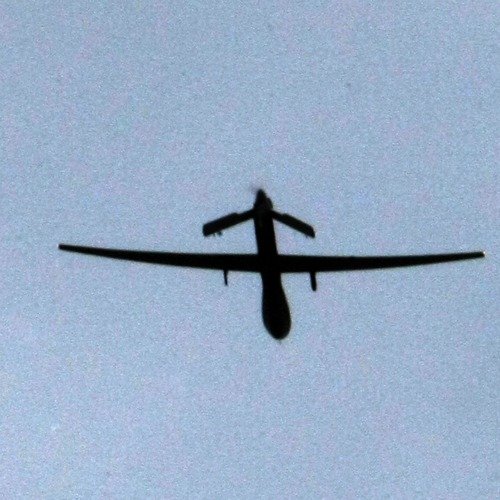BROOKE GLADSTONE: Our first two interviews are about facts, facts that have political resonance and consequences, and are elusive. First, facts about drone strikes. The Obama Administration has long been known to be hitting al Qaeda with drones in Pakistan, Yemen, Somalia and Afghanistan but the government rarely releases death tolls in these strikes and, even more rarely, information on civilian casualties.
Questions arise even when numbers are supplied. On Tuesday, a piece in The New York Times by Scott Shane and Jo Becker reported that according to several administration sources the government considers, quote, “All military-age males in a strike zone as combatants, unless there is explicit intelligence posthumously proving them innocent.”
Chris Woods is senior reporter for the Bureau of Investigative Journalism in the UK. Since 2010, he’s worked to confirm and map civilian deaths from drone strikes and covert actions in the Middle East and Africa. In February, his group released findings that conflicted with those of the CIA. US officials accused Woods’ group of being played by militants and Pakistani intelligence. Woods says the charge is absurd.
CHRIS WOODS: We take our information from a huge variety of sources, including US media, and from leaked intelligence documents, and from US intelligence officials themselves, on occasion when they speak to us. We speak to an enormous array of sources, among those sources, for example, Pakistani lawyers representing civilians killed in the drone strikes over in Pakistan.
One of those lawyers, US intelligence officials have labeled as an agent of Pakistani intelligence. I think that’s an absolutely laughable claim and, unfortunately, an indication of the extent to which the US intelligence community seems prepared to go to ridicule claims of civilian casualties in Pakistan and elsewhere. Our view is that instead of knocking down the messenger, we think that the CIA should be looking into those cases and making a decision about whether civilians actually died or not.
BROOKE GLADSTONE: So you don’t see any cases in which the US government is doing that? The President’s national security adviser says that the President is very closely involved in the decisions when it comes to these drone strikes and, and the reason is to feel comfortable that civilians won’t be inadvertently targeted.
CHRIS WOODS: Well, let’s be absolutely clear. The CIA claimed that between May 2010 and at least September 2011, and possibly right up to today, they haven’t killed a single civilian in Pakistan. Now, it is absolutely fair to say that particularly since late 2010 the proportion of civilians killed in US drone strikes has fallen, and that that’s absolutely de – demonstrable from the data that we collate. Unfortunately, as far as the CIA is concerned, it hasn’t killed any civilians.
BROOKE GLADSTONE: You have noted that American media, when it comes to these drone strikes, do a poor job of reporting on, quote, “collateral damage.”
CHRIS WOODS: There have been 17 CIA drone strikes in Pakistan in 2012. In only two of them have civilians credibly been reported as killed and, as far as I can tell, neither of those occasions were those civilian deaths reported in the United States. And we – unfortunately, we’ve seen that many times over. There are very big reports about particular-named militants killed, but when civilians are, unfortunately, killed, we seem to have this discord between what’s being reported internationally and what’s being reported within the United States. And I do wonder at that.
BROOKE GLADSTONE: Just to be clear, among 17 drone strikes in Pakistan –
CHRIS WOODS: In 2012, yeah.
BROOKE GLADSTONE: - in 2012, two have reportedly involved the death of civilians, reported all around the world, except in the US. I wish we had a larger pool with which to indict the American press.
CHRIS WOODS: Let’s, let’s cut back to what this is about. When you're a news editor and you're deciding what information you're going to give, why are other media doing something that the US apparently isn’t? And I think that is a valid question.
BROOKE GLADSTONE: Do you have an answer?
CHRIS WOODS: I think a lot of the reporting that takes place in the United States on drone-related matters is by national security correspondents, and there is a narrative in Washington that says that drones are a good thing and that reports of civilian deaths are exaggerated or are propaganda from militants - and I’ve heard that many times. You know, ultimately, as we’ve seen multiple intelligence leaks from administration figures, from agency figures, this is a rewards-based system, and if you annoy the intelligence community or you annoy your sources in the White House, you don’t get the goodies. And remember, for six months the claims by senior intelligence officials in the US that they weren’t killing civilians in Pakistan went completely untested in the United States. It took ourselves doing an investigation in July of last year to actually challenge that claim which, as I say, had gone on for seven months unchallenged by the US media.
BROOKE GLADSTONE: What are the stakes, do you think, for American news consumers? Why do they need to know this?
CHRIS WOODS: By repeating the message that no civilians are dying in places like Pakistan, we tell ourselves that the drone campaign is successful and then we start using more drones. But back on the ground in Pakistan, resentment towards the United States builds and builds. But I think, more broadly, given that we’re talking about a policy effectively of targeted killing - somewhere in the region of, of 3,000 people have died in covert US drones strikes - we have to be sure that what we’re doing is the best policy and that the longer-term consequences of, of that aren’t going to come back and haunt us.
BROOKE GLADSTONE: Chris, thank you very much.
CHRIS WOODS: A real pleasure.
BROOKE GLADSTONE: Chris Woods is senior reporter for the UK-based Bureau of Investigative Journalism.

